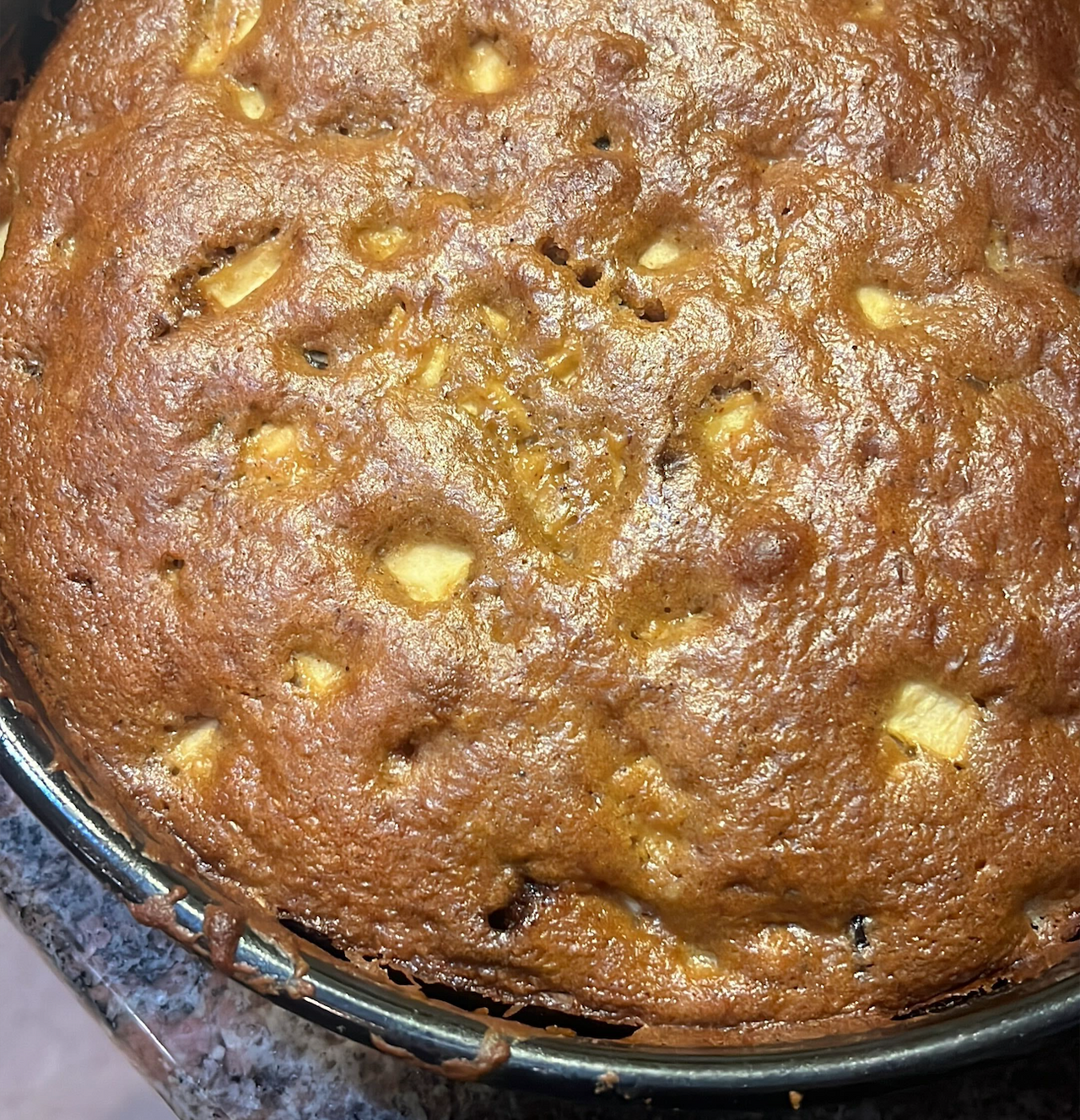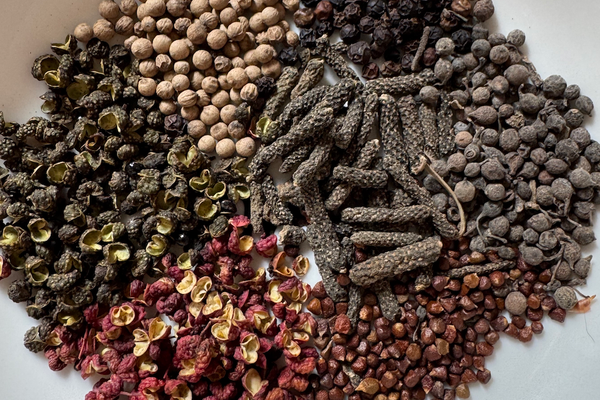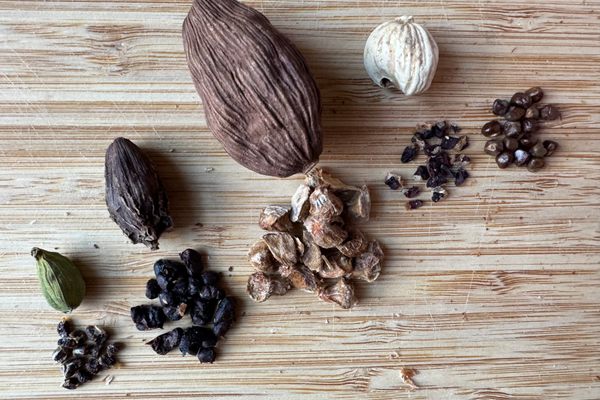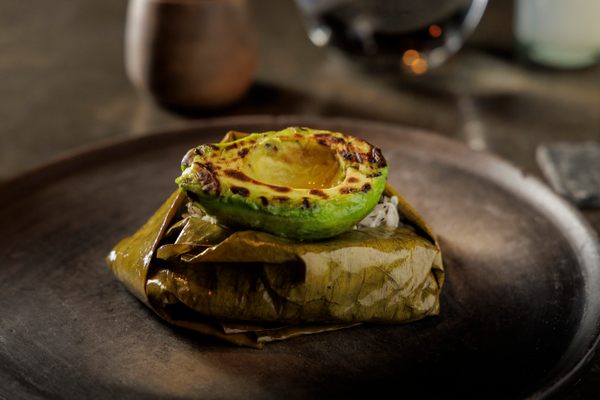Try These West African Spices in Your Holiday Baking
Have some fun with fusion.
THIS ARTICLE IS ADAPTED FROM THE DECEMBER 9, 2023, EDITION OF GASTRO OBSCURA’S FAVORITE THINGS NEWSLETTER. YOU CAN SIGN UP HERE.
If there’s one thing about the holiday season that gets me down, it’s everything tasting like cinnamon. It’s not that I hate cinnamon, exactly; I just don’t like how it hogs the spotlight in fall and winter when there are so many interesting spices from around the world that are underutilized in sweets and beverages this time of year.
The spices that give us a “warming” feeling—cinnamon, star anise, cloves, ground ginger, allspice, nutmeg, mace—get their distinctive flavor qualities from compounds called phenols and terpenes. A peek into the chemistry of spices reveals that many share flavor compounds in common with one another, meaning that there’s actually lots of combinations that can provide that same cozy, toasty feeling as your typical pumpkin spice blend.

This year for my holiday cooking and baking, I’ve been experimenting with spices that have similar flavor profiles to the usual wintry suspects. I’ve recently been studying West African cuisines and learning about a wealth of traditional ingredients previously unknown to me that are derived from plants native to the African continent.
When I purchase an ingredient I have never cooked with before, I always use it in its traditional context first by researching recipes. If you’re interested in learning about West African cuisines in general, the food blog Precious Core and the TikTok and Instagram accounts Eat With Afia and Yummy Medley are good places to start.
Once I’ve used something a few times and started to understand what it tastes like, how powerful it is, etc., then I feel like I can begin to experiment with it. It’s also important to note that for people from communities where these ingredients are commonplace, the idea of using them in experimental fusion recipes is nothing new: For example, consider Eat With Afia’s recipe for a West African fusion spice cake.

For my experiments this fall, I didn’t entirely abandon traditional warming spices. I ground up grains of paradise, ehuru, and grains of Selim along with cinnamon, star anise, allspice, and cloves to create a custom “warm” blend that I used in several recipes, such as apple cake and apple butter. To figure out the proportions, I used my custom spice powder in the same quantity as the total ground spices called for in the recipe. Another spice, prekese, was incorporated in a different way that I’ll explain below.
I also used the warm spice blend for the roast duck I made for Thanksgiving: About one tablespoon of the blend went into the salt that I rubbed all over the duck to cure it in the fridge overnight, and two teaspoons into the stuffing, which included sautéed onion and apples with some orange slices. In the final 15 minutes of roasting, the duck was basted with a mixture of honey, orange juice, and one more tablespoon of the spice blend.
I was pleased with how all of these recipes turned out! In particular, the apple butter and apple cake acquired a warm, woodsy flavor that was not quite like anything I’ve tried before; at Thanksgiving dinner, one family member asked if the apple cake was made with rum (it was not).
This week, Gastro Obscura is offering a primer on four unique spices drawn from the cuisines of West Africa, and how you can apply them in your holiday recipes. As for acquiring these spices, I purchased mine from Eddie’s Place African Market, which is a fairly large West African store in the Bronx that primarily carries Nigerian and Ghanaian products. Another store I can recommend in New York City is Adja Khady in Harlem, which tends to have more stuff from Francophone countries like Senegal and Cameroon. South Asian stores may also carry some of the spices below, especially grains of paradise.
If you don’t have access to an international grocery store, all of the spices described are available for purchase online, for example from Zoe’s Ghana Kitchen.
Prekese

This dramatic-looking seed pod comes from a tree in the bean family. (Did you know that “tree” is not a botanical family of related plants, just a name we call any plant that looks treeish?) Prekese is the spice’s name in the Twi language of Ghana, but in the Igbo language of Nigeria, it’s known as uhio. Other names include aiden fruit, or my personal favorite: “soup perfume,” which tells you exactly how it’s traditionally used.
The moment you pick up a pod of prekese you’ll notice its strong scent, reminiscent of vanilla and brown sugar or molasses. Prekese is traditionally used to add fragrance and a mild sweetness to savory stews, as well as in drinks. It also lends itself well to desserts, where its natural light sweetness can be enhanced by the addition of sugar, especially recipes that involve boiling liquid.
Some recipes use prekese powder, but many use the whole pods cooked in liquid, and this is the only way I have cooked with it. Prekese pods should be toasted over the stove before using, and you should also cut into them with scissors or a knife to release their maximum flavor. As the pods are quite large, just one or even half may be enough for one recipe.
I didn’t use prekese in my custom spice blend, but I used it in several recipes where I could cook the pod in liquid. When making my apple butter, I cooked the apples in a pressure cooker until they were soft, then blended them with an immersion blender, uncovered the pot, and added a prekese pod as the mixture continued to reduce down into apple butter. I removed the pod after about one hour. I found that, thanks to the prekese, my apple butter tasted like it had vanilla in it even though it didn’t, with an additional depth or richness that vanilla lacks by itself.
Boiling prekese pods with ginger, lemon, honey, and other spices like cloves produces a delicious spiced tea. Another place I used prekese this Thanksgiving was to make a fusion coquito (Puerto Rican coconut “eggnog”). While the primary flavorings in coquito are coconut milk and sweetened condensed milk, the best coquito starts with a tea of ginger and spices as the base. I incorporated prekese (and grains of Selim) into this tea before adding the coconut milk and other ingredients, as well as a pinch of my warming spice blend. This tasted like a spiced coconut vanilla ice cream and was especially delicious with white rum.
Ehuru
Ehuru is sometimes known as “calabash nutmeg,” which I find strange because calabash is a type of gourd that grows on a vine, and ehuru comes from a tree. Historically, it was widely used as a cheaper substitute for nutmeg, including during the colonial era in Jamaica, where it is still grown today. For this reason you may see ehuru called “Jamaican nutmeg,” although it’s indigenous to Africa.
I find it to be similar in flavor to nutmeg but much milder and less pungent, so it might be a good choice if you want to capture some nutmeg flavor without it becoming overpowering.
Ehuru has similar warming terpenes to those found in Myristica fragrans, the tree that produces both nutmeg (its seed) and mace (its seed covering). These compounds evaporate easily and tend to disappear with prolonged cooking, meaning that, as with nutmeg, you may wish to sprinkle powdered ehuru onto dishes before serving. While I haven’t made it personally, I came across an intriguing fusion recipe for compound butter made with ehuru and wildflower honey.
Grains of Selim

Selim is a common name in some parts of the world, but this spice probably got its name from the Selim ethnic group of Sudan. It’s also called hwentea and uda pepper, and, confusingly, some of its many names may also be applied to other spices.
The first thing you’ll notice about grains of Selim is that they smell smoky, and this is because most of the commercially-available dried seedpods are smoked over a fire. The same is true for the black cardamom pods used in India and China. Black cardamom is also the spice I would compare grains of Selim to in terms of scent and flavor: not only smoky but sharp, resinous, and woodsy, and far less sweet than green cardamom.
Both cardamom and grains of Selim contain penetrating terpene compounds that can easily overpower other flavors, unless they’re used sparingly or balanced with other spices. One of the major flavor compounds found in grains of Selim is shared with fennel, so you might especially consider pairing it with fennel, anise, or star anise. In Indian cooking, black cardamom is typically used in savory dishes and green cardamom in sweet. I’d also recommend more savory preparations for grains of Selim, but you can still use them in sweet dishes, as I did this Thanksgiving, if you’re careful not to use too much.
In West and East Africa, grains of Selim are often included in spice blends or in spiced teas, sometimes with cloves. They’re also roasted and ground along with cloves and coffee beans, in a ratio of about one part spices to four parts beans, to make Senegalese spiced coffee, or café Touba. For Thanksgiving, I used it along with cloves and prekese in the tea for my fusion coquito, and just a small amount in my custom warm spice blend.
Grains of Paradise

Grains of paradise were quite popular in Europe in ancient and medieval times, at least for people wealthy enough to import the spice for their tables. The name appears to have been cooked up by spice traders as an early example of marketing; in Roman times, the spice was simply called “African pepper” to distinguish it from black pepper, which comes from Asia.
Grains of paradise are unrelated to grains of Selim, but one thing the two have in common is that both have many names that may be applied to several other spices. However, grains of paradise’s pyramidal, slightly purplish or pinkish grains give them a distinctive appearance.
While grains of paradise have a similar kick to black pepper, they also have an almost citrusy brightness that is more reminiscent of pink peppercorns. You can use them anywhere you would use black pepper, including sprinkled on dishes or in rubs and spice blends. I added just a small amount to my warming spice blend, since I didn’t want to end up with spicy apple butter, but maybe that’s your thing.
However, grains of paradise do have sweet applications. The ancient Romans added a dusting of African pepper to dulciae (sweets) like honeyed dates stuffed with nuts and honey-soaked twists of fried dough. Both the Romans and medieval Europeans used grains of paradise in their mulled wine, and on the cooking show Good Eats, Alton Brown added them to his apple pie.
Gastro Obscura covers the world’s most wondrous food and drink.
Sign up for our regular newsletter.




























Follow us on Twitter to get the latest on the world's hidden wonders.
Like us on Facebook to get the latest on the world's hidden wonders.
Follow us on Twitter Like us on Facebook